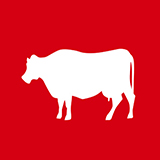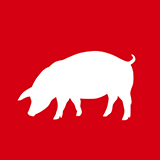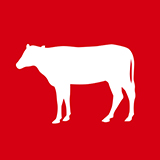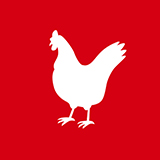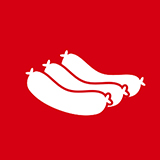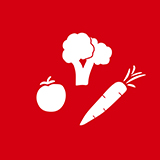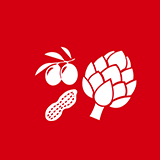BEEF
PORK
The chuck primal cut extends from the neck to the fifth rib and includes the shoulder blade and upper arm.. The texture varies from coarse to fine and so does the degree of tenderness. The chuck has plenty of connective tissues that melt when the meat is cooked. This helps to add flavor and also helps to tenderize the meat. Although chuck cuts are flavorful, they are not as tender as the loin and rib cuts.They can become rather tough if not cooked properly. Cuts from the chuck benefit from slow cooking using moist heat methods such as braising.
Uses
- Whole or rolled chuck / chuck tender – Pot-roast
- Cubes (30mm) – Stew
- Mince
Blade steak comes from the shoulder blade. It is a versatile cut that can be barbecued and pan-fried, cut into strips and stir-fried or diced for slow-cooking in a braise. The oyster blade is connected to the shoulder blade of the beef. It is a very flavourful cut that is versatile enough to be cooked whole as a roast, sliced into steaks and cooked on the barbecue or in a pan, thinly sliced for a stir-fry or diced for slow cooking in a braise or casserole.
Uses
- Cubes – Braise, stew
- Strips – Stir-fry, sauté
- Cubes – Kebabs, stew, deep-fry
- Whole -Oven-roast
- Steaks – BBQ -Grill
The shin consists of a large proportion of bone and a lot of white connective tissue (collagen), which makes this a tough but tasty cut. This is one of the least expensive cut and is best to use a moist, slow cooking method to produce a tender and tasty meat.
Uses
- Cubes – Braise, stew
The beef carcass has 13 pairs of ribs, but not all of the ribs are included in the rib primal cut. The first 5 ribs are part of the chuck cut in the front of the animal. The 13th rib is part of the loin. The rib primal contains ribs 6 through 12. A bone-less prime rib is known as the ribeye. The cuts obtained from the rib primal are very tender and contain many of the best steaks and roasts. Dry heat cooking methods, such as grilling, pan-frying and roasting, bring out the flavor of rib cuts and keep the meat tender.
Uses
- Whole prime rib (2 – 7 ribs) – Oven-roast
- Prime rib steak – Oven-roast, grill, BBQ
- Whole ribeye – Oven-roast
- Ribeye steak (also called Scotch Fillet) – Pan-fry, grill or BBQ
Short rib refers to a small piece that has been trimmed of the main portion of a rib when the rib section is trimmed into smaller cuts. It is the continuation of the prime rib towards the brisket (belly). Short ribs cut parallel to the bone are known as English style beef ribs. Short ribs that are cut across the rib bones are commonly used in Japanese and Korean dishes (LA Kalbi). These ribs are usually marinated for a period of time to achieve the desired tenderness.English style beef ribs can be braised or steamed first before roasting or barbequing so that the meat remains juicy and tender when cooked.
Uses
- Beef ribs – Brown & braise, BBQ
- Short ribs, cut – Marinate & grill
The brisket consists of the point end and the navel end.This flavoursome cut located on the underside of the animal below the chuck primal has a coarse and stringy texture. It contains the breastbone and the lower ends of ribs 1-5.
Uses
- Whole brisket, rolled – Pot-roast
- Portioned brisket – Stew, braise
The short loin is the most tender of the primal cuts because the muscles in this area are the least used. The sirloin muscle is the largest muscle and the tenderloin is the smaller inside muscle.They are very lean, but usually lack the flavor of some of the tougher beef cuts that contain more fat and connective tissue. It is best to cook beef cuts from the short loin with dry heat cooking methods such as grilling and roasting. It is important not to overcook loin cuts because they can loose their natural tenderness, which is one of the primary reasons for purchasing them.
Uses
- Whole sirloin – Oven-roast (Alternate use: Cold roast beef sliced thinly)
- Sirloin steak (also known as NY strip, porterhouse, entrecôte) – Pan-fry, grill, BBQ
- T-Bone or porterhouse – Pan-fry, grill, BBQ
The rump consists of several loose muscle layers and the large pelvic bone. It is located between the short loin and the leg and includes the hip section and ends at the socket of the pelvis. Cuts such as the rump, rump cap and tri-tip from the rump are flavorful and tender, but they are a bit less tender than cuts from the short loin.
Uses
- Whole rump – Pot roast, Oven-roast
- Rump steaks (Minute steaks) – Pan-fry, grill or BBQ
- Strips – Stir-fry, sauté
- Cubes – Kebabs, stew, deep-fry
The flank consists of a bone-less section located on the underside of the animal below the loin primal. It contains cuts like the
flank steak (also know as Bavette, London Broil) and flap meat/skirt which are very flavourful and sufficiently tender when cooked
properly. These cuts are also commonly used in Mexican cooking,tenderized with a marinade and used to fill tacos, fajitas or as a main
course.
Uses
- Flank steak & flap meat – Pan-fry or grill not more than medium in doneness
- Strips – Stir-fry, sear
Beef cuts from the leg are located in the rear portion ofthe carcass, which includes cuts such as the topside, knuckle,silverside and eye round. Cuts from the round primal are lean, but not necessarily tender. The fat and marbling that is present in some of the other primal beef cuts help to tenderize and flavor the meat as it cooks. Because of the limited quantity of marbling, round cuts benefit
from a moist, slow cooking method such as braising in order to produce a tender and flavorful meat.
Uses
- Topside – Pot roast, braising
- Silverside – Corned beef, pastrami
- Mince
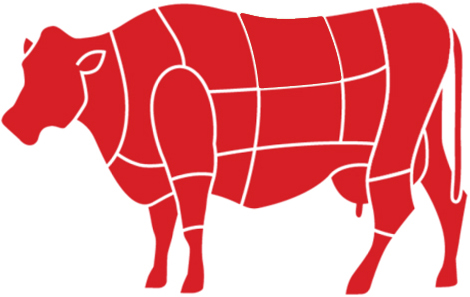
Pork neck is the front part of the back rack up to the 4th or 5th rip. I tis well marbled and great for Roasts, Neck Steaks or
Pulled pork. In germany it is very popular for BBQ as marinated pork neck steak.
Pork shoulder is the top portion of the front leg of the hog. The terminology for pork shoulder can vary widely depending on the region. The upper part of the shoulder, often called the blade pork roast, The blade roast is a well-marbled cut. This versatile
cut can be pot-roasted whole, cut up for stews or cooked over moist smoke in a smoker to transform it into classic pulled pork barbecue. Whether it isroasted, braised or barbecued, blade roast becomes meltingly tender and deliciously flavorful.
The pork knuckle is covered by a thick layer of fat and displayes a very well marbled texture. It is very flavourfull and tender
but needs to be cooked for longer periods. The skin shoudl be easily removable indifferent of the cooking method such as stewing or grilling.Very Popular across germany as Schweinshaxe.
Pork rib roast or rack of pork originate in the rib area of the loin that runs from the pig’s hip to shoulder.It contains a bit more fat which makes it flavorful. This primal cut of the pork can be also be used for pork Chops. Pork chops are the most popular cut from the pork loin. Depending on where they originate, pork chops can be found under a variety of names, including loin, rib, sirloin, top loin and blade chops.
Spareribs come from the belly of the hog and are known for their delicious, meaty pork flavor. These ribs are the least meaty variety of ribs, but full of flavor. Spareribs are typically larger and heavier than back ribs.When prepared for BBQ, Ribs are commonly prepared with either “wet” or “dry.” Ribs rubbed with a mixture of herbs and spices are called dry ribs. Such rubs can be applied just before barbecuing.Ribs basted with sauces during the barbecuing process are called wet ribs. For best results, brush ribs generously during the last 30 minutes of cooking to prevent burning. Ribs are also highly popular in Chinese cooking
Pork belly comes from a hog’s ‘belly’ or underside after the loin and spareribs have been removed. This boneless cut may be served fresh, or cured or smoked.Fresh belly is succulent and richly flavorful and is often served in small portions. Pork belly is at its best and is most tender when prepared using a slow cooking method, such as braising. Pork belly also is a popular menu item among restaurant chefs who appreciate its versatility, flavor and texture. It benefits form a slow cooking method such as braising or roasting to bring out its full potential.
Fresh pork leg, also known as fresh ham, is the uncured hind leg of the hog. The whole bone-in leg weighs between 15 and 25 pounds and includes the shank and leg bones. It consists of a variety of cuts such as topside, silverside and shank that can be used for a variety of cooking methods and dishes.The Topside is great for short sauted pieces of meat or schnitzelsSilverside suits itself great for Roast and Broiling Other parts are great for Schnitzel , Steaks , Stirfry, Stew or for cold cuts such as cooked and baked ham.
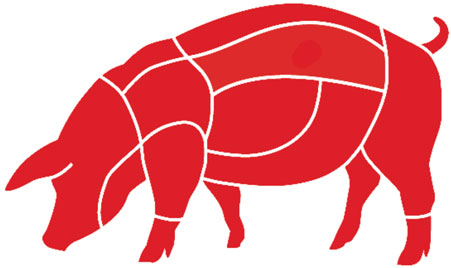
BEEF
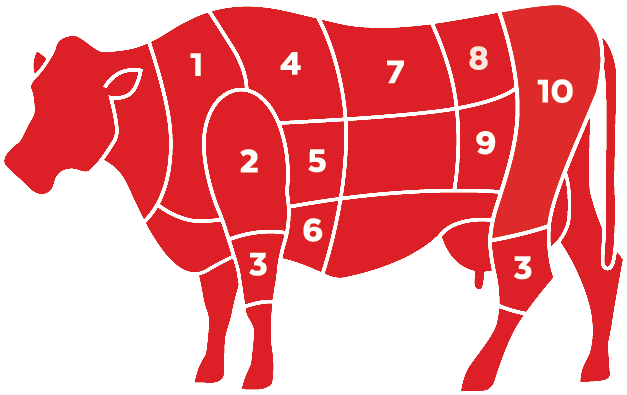
The chuck primal cut extends from the neck to the fifth rib and includes the shoulder lade and upper arm.. The texture varies from coarse to fine and so does the degree of tenderness. The chuck has plenty of connective tissues that melt when the meat is cooked. This helps to add flavor and also helps to tenderize the meat. Although chuck cuts are flavorful, they are not as tender as the loin and rib cuts. They can become rather tough if not cooked properly. Cuts from the chuck benefit from slow cooking using moist heat methods such as braising.
● Whole or rolled chuck / chuck tender – Pot-roast
● Cubes (30mm) – Stew
● Mince
Blade steak comes from the shoulder blade. It is a versatile cut that can be barbecued and pan-fried, cut into strips and stir-fried or diced for slow-cooking in a braise. The oyster blade is connected to the shoulder blade of the beef. It is a very flavourful cut that is versatile enough to be cooked whole as a roast, sliced into steaks and cooked on the barbecue or in a pan, thinly sliced for a stir-fry or diced for slow cooking in a braise or casserole.
● Cubes – Braise, stew
● Strips – Stir-fry, sauté
● Cubes – Kebabs, stew, deep-fry
● Whole -Oven-roast
● Steaks – BBQ -Grill
The shin consists of a large proportion of bone and a lot of white connective tissue (collagen), which makes this a tough but tasty cut. This is one of the least expensive cut and is best to use a moist, slow cooking method to produce a tender and tasty meat.
● Cubes – Braise, stew
The beef carcass has 13 pairs of ribs, but not all of the ribs are included in the rib primal cut. The first 5 ribs are part of the chuck cut in the front of the animal. The 13th rib is part of the loin. The rib primal contains ribs 6 through 12. A bone-less prime rib is known as the ribeye. The cuts obtained from the rib primal are very tender and contain many of the best steaks and roasts. Dry heat cooking methods, such as grilling, pan-frying and roasting, bring out the flavor of rib cuts and keep the meat tender.
● Whole prime rib (2 – 7 ribs) – Oven-roast
● Prime rib steak – Oven-roast, grill, BBQ
● Whole ribeye – Oven-roast
● Ribeye steak (also called Scotch Fillet) – Pan-fry, grill or BBQ
Short rib refers to a small piece that has been trimmed of the main portion of a rib when the rib section is trimmed into smaller cuts. It is the continuation of the prime rib towards the brisket (belly). Short ribs cut parallel to the bone are known as English style beef ribs. Short ribs that are cut across the rib bones are commonly used in Japanese and Korean dishes (LA Kalbi). These ribs are usually marinated for a period of time to achieve the desired tenderness. English style beef ribs can be braised or steamed first before roasting or barbequing so that the meat remains juicy and tender when cooked.
● Beef ribs – Brown & braise, BBQ
● Short ribs, cut – Marinate & grill
The brisket consists of the point end and the navel end. This flavoursome cut located on the underside of the animal below the chuck primal has a coarse and stringy texture. It contains the breastbone and the lower ends of ribs 1-5.
● Whole brisket, rolled – Pot-roast
● Portioned brisket – Stew, braise
The short loin is the most tender of the primal cuts because the muscles in this area are the least used. The sirloin muscle is the largest muscle and the tenderloin is the smaller inside muscle. They are very lean, but usually lack the flavor of some of the tougher beef cuts that contain more fat and connective tissue. It is best to cook beef cuts from the short loin with dry heat cooking methods such as grilling and roasting. It is important not to overcook loin cuts because they can loose their natural tenderness, which is one of the primary reasons for purchasing them.
● Whole sirloin – Oven-roast (Alternate use: Cold roast beef sliced thinly)
● Sirloin steak (also known as NY strip, porterhouse, entrecôte) – Pan-fry, grill, BBQ
● T-Bone or porterhouse – Pan-fry, grill, BBQ
The rump consists of several loose muscle layers and the large pelvic bone. It is located between the short loin and the leg and includes the hip section and ends at the socket of the pelvis. Cuts such as the rump, rump cap and tri-tip from the rump are flavorful and tender, but they are a bit less tender than cuts from the short loin.
● Whole rump – Pot roast, Oven-roast
● Rump steaks (Minute steaks) – Pan-fry, grill or BBQ
● Strips – Stir-fry, sauté
● Cubes – Kebabs, stew, deep-fry
The flank consists of a bone-less section located on the underside of the animal below the loin primal. It contains cuts like the flank steak (also know as Bavette, London Broil) and flap meat/skirt which are very flavourful and sufficiently tender when cooked properly. These cuts are also commonly used in Mexican cooking, tenderized with a marinade and used to fill tacos, fajitas or as a main course.
● Flank steak & flap meat – Pan-fry or grill not more than medium in doneness
● Strips – Stir-fry, sear
Beef cuts from the leg are located in the rear portion of the carcass, which includes cuts such as the topside, knuckle, silverside and eye round. Cuts from the round primal are lean, but not necessarily tender. The fat and marbling that is present in some of the other primal beef cuts help to tenderize and flavor the meat as it cooks. Because of the limited quantity of marbling, round cuts benefit from a moist, slow cooking method such as braising in order to produce a tender and flavorful meat.
● Topside – Pot roast, braising
● Silverside – Corned beef, pastrami
● Mince
PORK
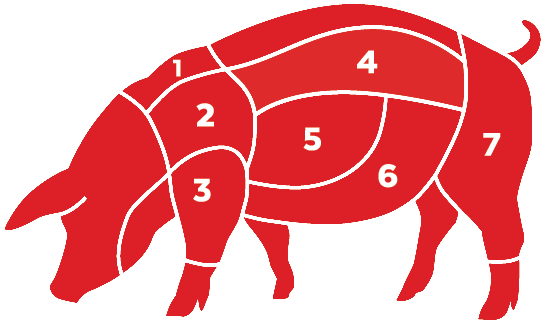
Pork neck is the front part of the back rack up to the 4th or 5th rip. I tis well marbled and great for Roasts, Neck Steaks or Pulled pork. In germany it is very popular for BBQ as marinated pork neck steak.
Pork shoulder is the top portion of the front leg of the hog. The terminology for pork shoulder can vary widely depending on the region. The upper part of the shoulder, often called the blade pork roast, The blade roast is a well-marbled cut. This versatile cut can be pot-roasted whole, cut up for stews or cooked over moist smoke in a smoker to transform it into classic pulled pork barbecue. Whether it isroasted, braised or barbecued, blade roast becomes meltingly tender and deliciously flavorful.
The pork knuckle is covered by a thick layer of fat and displayes a very well marbled texture. It is very flavourfull and tender but needs to be cooked for longer periods. The skin shoudl be easily removable indifferent of the cooking method such as stewing or grilling. Very Popular across germany as Schweinshaxe.
Pork rib roast or rack of pork originate in the rib area of the loin that runs from the pig’s hip to shoulder.
It contains a bit more fat which makes it flavorful. This primal cut of the pork can be also be used for pork Chops. Pork chops are the most popular cut from the pork loin. Depending on where they originate, pork chops can be found under a variety of names, ncluding loin, rib, sirloin, top loin and blade chops.
Spareribs come from the belly of the hog and are known for their delicious, meaty pork flavor. These ribs are the least meaty variety of ribs, but full of flavor. Spareribs are typically larger and heavier than back ribs.
When prepared for BBQ, Ribs are commonly prepared with either “wet” or “dry.” Ribs rubbed with a mixture of herbs and spices are called dry ribs. Such rubs can be applied just before barbecuing. Ribs basted with sauces during the barbecuing process are called wet ribs. For best results, brush ribs generously during the last 30 minutes of cooking to prevent burning. Ribs are also highly popular in Chinese cooking
Pork belly comes from a hog’s ‘belly’ or underside after the loin and spareribs have been removed. This boneless cut may be served fresh, or cured or smoked.
Fresh belly is succulent and richly flavorful and is often served in small portions. Pork belly is at its best and is most tender when prepared using a slow cooking method, such as braising. Pork belly also is a popular menu item among restaurant chefs who appreciate its versatility, flavor and texture. It benefits form a slow cooking method such as braising or roasting to bring out its full potential.
Fresh pork leg, also known as fresh ham, is the uncured hind leg of the hog. The whole bone-in leg weighs between 15 and 25 pounds and includes the shank and leg bones. It consists of a variety of cuts such as topside, silverside and shank that can be used for a variety of cooking methods and dishes.
The Topside is great for short sauted pieces of meat or schnitzels
Silverside suits itself great for Roast and Broiling
Other parts are great for Schnitzel , Steaks , Stirfry, Stew or for cold cuts such as cooked and baked ham.

